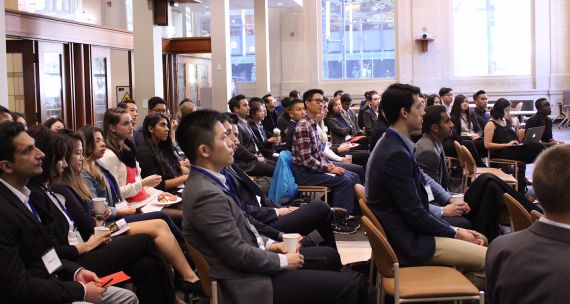We hear a lot of talk these days about the need for Canada to re-engage with Asia and to become more aware of the opportunities Asia offers in business. One element of this is the need to strengthen the Asia competencies of Canadians by introducing them to the challenges and opportunities of doing business in the Far East.
We recently returned from a field residency in China and Korea under the auspices of the MBA in executive management program at Royal Roads University, which for the first time is offering an Asia-Pacific trade and investment specialization. In preparation, the students - all mid-career professionals - read both background material and business cases focused on Asia's development model and the opportunities and challenges for companies in the region, and specifically China and Korea.
The field residency started in Shanghai, and took us to Hangzhou, where we visited Alibaba's headquarters, and to Seoul and Suwon, where Samsung's digital city is located. In both Shanghai and Seoul, we had discussions with Canadian business people living and operating there, facilitated by the Canadian chambers of commerce in those cities, and met with trade commissioners from Global Affairs Canada, and with the B.C. Trade and Investment Office, among others. What did all this tell us? First, Canada has a positive brand in both countries, associated with a relatively pristine environment and high quality food, but not much profile in high-tech and manufacturing, where we would like to be more recognized. We found while there are a number of Canadians who hold important positions in major global companies such as GE and Samsung, and we met several Canadian expats starting their own companies, the presence of Canadian companies overall is lacking. We were told the largest Canadian-owned company in South Korea, the world's 11thlargest economy, employs less than 200 people. Opportunities exist in clean technology, health care, services, consumer products and education, but the bulk of Canadian exports to these countries are still in commodities. When prices for commodities fall, as has happened lately, Canada's trade drops.
The trip reinforced the message that opportunities exist in Asia, but Canada needs to be ready for the size, speed and diversity of the markets in Asia. China captures most of the buzz in the press, but countries such as South Korea may offer better opportunities because they are closer in size to the Canadian market. The rapid expansion of e-commerce in the region creates new opportunities, but businesses must contend with the so-called Great Firewall in China and pay careful attention to government regulations. Asian markets are also not monolithic - China contains hundreds of different geographic markets, and selling to the new generation of Asian millennials is very different from selling to their parents' generation. Businesses need to do their homework to understand the history, complexities and changing demographics in the region, and to adapt their brands to the market.
We heard tales of businesses that lost out because they did not understand sensitive issues related to historical grievances and territorial disputes, but also tales of success from companies such as Canada Goose and Lululemon that have been able to tap into a fast-growing youth culture that is seeking global brands and experiences. Successful
businesses often spent years preparing to launch, but everyone we met felt those years were well invested given the growing importance of the Asian market in global business.
One take-away from the experience was the importance of seeing Asia in person. Both of us spent years working and living in Asia, but those experiences are hard to convey to students in the classroom or online. Personal stories, textbook readings and videos can't re-create the learning that occurs for students when they actually arrive in the region. Sights, sounds and smells are key factors in making sense of prior readings, and help shape understanding long after you return home.
We learned the importance of going beyond the news headlines by talking directly with a variety of local sources. Canadians often hear that China is in the midst of a massive economic crisis and South Korea is at a standstill due to the threats from its belligerent neighbour to the north. However, on the ground the students were told a very different story of a China that is in the midst of a historic shift to a consumer-and knowledge-led economy, and a South Korea that is racing to the top of the technology sector.
This was just one short residency within one program at one Canadian university, but it is the type of program that needs to be expanded to build ties between Canada and Asia. All the students on the program intend to use their new-found knowledge to better engage Asia - both through looking for opportunities for new business in the region and through an enhanced understanding of their colleagues in Canada who have come from Asian backgrounds. Expanding the consciousness and exposure of Canadian students - especially business students - is essential. We have goodwill, and a generally positive, if somewhat low-profile, brand image to build on. We have networks of professionals in the region in both government and the private sector. Now we need to connect the dots and build better Asian competencies.
This piece was first published April 4, 2016 in The Vancouver Sun.



